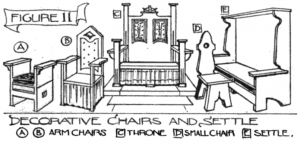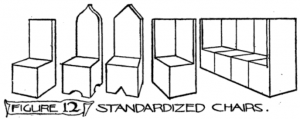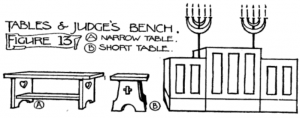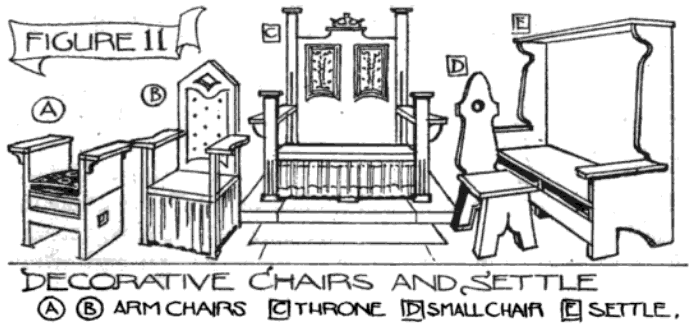The following is taken from a chapter concerning prop-making in “Shakespeare for Community Players”, by Roy Mitchell. It was originally published in 1919. The information suffers from being both 90 years old, as well as being written for amateurs. Still, it is useful for some tips and tricks, as well as its historical value. I will be presenting sections of the chapter intermittently over the next several weeks.
Furniture
The making of properties is the most fascinating of all the crafts connected with the art of the theatre. Seeing that the intent is primarily to suggest a given object, there is no attempt at imitation in detail. Only the salient facts regarding the object are to be seized and translated into a suitable medium. The finding of the particular medium in each case, and the discovery of common, inexpensive objects which can easily be converted to use, gives unfailing interest to property-making. Every play, with its wide variety of accessories, is in itself a great adventure.
Under the heading of “properties” comes everything movable on stage except scenery, rostra and clothes. Even clothes, if they are not worn but merely carried on and passed from one person to another, are ” props,” although they are made by the costumier.

Furniture is the most considerable item among stage accessories. This should be made on the simplest and most massive lines. Whenever possible, it is best to make up furniture on the unit system, where a few pieces used in combination can be made to serve many purposes. Figure 11 shows a variety of chairs and a settle. Figure 12 shows a standardised set of chairs which will be universally useful. In this set there are three plain chairs and two corner chairs which make up into a throne, a settle, or a garden seat.

Figure 13 shows two tables and a judge’s bench. The first (a) is most generally useful. It is quite narrow (two feet wide), and, placed across the stage in any desired position, will occupy a minimum of space, on even the shallowest of stages. The table shown in (b) is shorter, and may be used up and down the stage. The judge’s bench should be high and quite shallow; sixteen inches is enough. Any of these tables may be converted into a desk by placing on the centre of it a simple inclined bookrest.

Buffets, cupboards, wardrobes and chests should be of the most elementary design, made up out of pine and stained or painted.
Very satisfactory stains may be made of dye in powder form, dissolved in boiling water and applied with a dish-washing mop. Black, green, brown, red or orange may be used singly or mixed in desired combinations to give all the natural and artificial tones of wood with sufficient fidelity for stage purposes.
Reprinted from Shakespeare for Community Players, by Roy Mitchell, J.M. Dent & Sons ltd., 1919 (pp 60-62)

